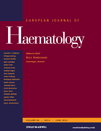Primary gastric diffuse large B-cell Lymphoma (DLBCL): analyses of prognostic factors and value of pretreatment FDG-PET scan
Abstract
Objectives: We report a single institution experience with gastric diffuse large B-cell lymphoma (DLBCL) in an attempt to evaluate the roles of different treatment modalities, to assess the value of pretreatment positron emission tomography (PET) scan, and to identify potential prognostic factors. Methods: Among 384 patients diagnosed with DLBCL between 1995 and 2008, 75 patients had primary gastric DLBCL and were reviewed and analyzed. Results: The median age was 66. International prognostic index (IPI) risk was low in 52%, low-intermediate in 23%, high-intermediate in 9%, and high in 16%. Pretreatment PET scan was highly sensitive in detecting gastric lesions except stage I gastric DLBCL without detectable mass by CT or gastroscopy. As a general rule, patients with limited-stage disease were treated with three times of CHOP (with or without rituximab) and radiotherapy, and those with advanced-stage disease were treated with eight cycles of CHOP (with or without rituximab), and radiotherapy was given to residual diseases after chemotherapy. Three-year overall survival (OS) rate was 78%. Multivariate analysis revealed that low albumin, hemoglobin <12.0 g/dL, and treatment without rituximab were independently associated with shorter OS. Low albumin, hemoglobin <12.0 g/dL,and advanced stage were independently associated with shorter progression-free survival. Conclusion: We showed the survival benefit of rituximab and potential prognostic value of pretreatment hemoglobin and serum albumin levels in gastric DLBCL.




